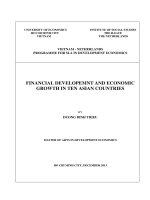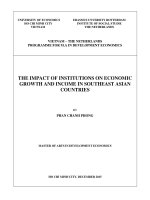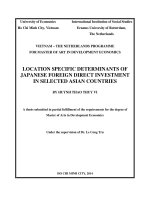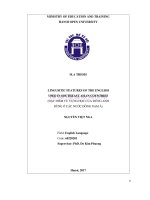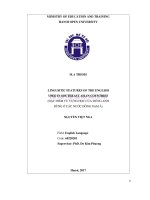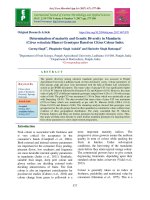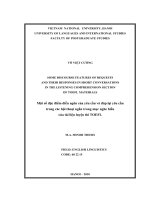Some historical features of legal and cultural diversity in Southeast Asian countries
Bạn đang xem bản rút gọn của tài liệu. Xem và tải ngay bản đầy đủ của tài liệu tại đây (105.3 KB, 8 trang )
SOME HISTORICAL FEATURES OF LEGAL AND CULTURAL
DIVERSITY IN SOUTHEAST ASIAN COUNTRIES
Nguyen Xuan Thuy*, Ta Thi Thu Hue, Nguyen Hoang Minh
People's Police Academy, Vietnam
*Corresponding Author:
ABSTRACT
Each country in Southeast Asia has one characteristics of history, tradition, geography,
population composition, economic, political and religious development levels ... which
are the foundation for creating diversity of social and legal system for this area.
However, in that diversity there are certain similarities. The exchanges and
acculturation between cultures, historical similarities, ethnic traditions of countries in the
region have created favorable conditions for the legal systems in this region to have
same points. Moreover, we not only find many similarities between these legal systems,
but also many similarities between them and the legal systems outside of Southeast
Asia. Based on the classification of comparative law scholars in the world, we will find it
quite interesting to identify the lineages of the legal systems in ASEAN countries
Accordingly, most of the legal system of the The country contains elements of two or
more different legal cultures. In other words, the laws of Southeast Asia countries
contain all the cultural elements of the legal systems in the world.
Keywords: Law, cultural diversity, legal culture, Southeast Asia.
1 INTRODUCTION
Legal culture, legal system, legal family, geo-jurisprudence, pattern of law, traditional
law (legal tradition) are terms that have been used quite commonly in the field of
comparative law of legal science in the world. In the above-mentioned approaches,
legal culture is a method that helps lawyers to compare the access to national legal
systems from the depth of culture and history as well as other economic, political and
social conditions. Professor Pierre Legrand of Panthéon-Sorbonne University of the
Republic of France affirmed: “Culture is a silent language that plays an important role in
helping us not only understand the laws of materiality (propositions, actual laws) but
more importantly it helps. We understand the reason, the mode of birth and the
existence of each legal system, the goals that a community expects to achieve through
the enactment of that law. Laws are a cultural phenomenon, lawyers will not be able to
fully understand a legal system if it is placed outside the cultural context in which it
exists”.
In Southeast Asian countries, culture is the core element and the most sustainable part
of each legal system, this is also the most stable part of the law, helping the legal
system have inheritance from one generation to the next. Culture and law have a
158
dialectic relationship with each other. The dangers of the entrenched habit behind
customary strongholds, the tradition of law was identified by Thomas Jefferson - the
third President of the United States in a letter to Samuel Kercheval on July 12, 1816:
“The law and its institutions go hand in hand with the advancement of the human mind.
When that element of consciousness was developed and enlightened to a higher level,
when new discoveries were made, when new truths were revealed, and when customs
and perspectives change with circumstances, those institutions must also progress to
keep pace with the times. Could it be that we forced the man to continue wearing the
shirt he had been busy with as a child ... ”.
In the process of development of the history of Southeast Asian countries, old cultural
traditions, which are not suitable to the new situation, will gradually disappear, new
factors will arise and gradually become new cultures. This new chemical is concretized
by the State through the legal system through periods. However, the sustainability of
the legal culture is also relative. It can be said that the legal systems have all the
elements of a tradition, including the past, the ability to govern the present and the
transmission of values from the past to the present. The law is a deeply traditional
social phenomenon, we can find the traditional elements in most legal systems. The
laws of nations, therefore, the study of the history of the formation of the legal culture in
Southeast Asian countries is necessary.
2 SOME LEGAL AND CULTURAL MODELS EXISTING IN SOUTHEAST ASIAN COUNTRIES
Civil legal culture in ASEAN countries
Civil law adopted in many ASEAN countries is mainly associated with the process of
colonization by continental European countries for these countries. Except for
Thailand, the laws affected by Civil law are Vietnam, Laos, Cambodia, Indonesia and
the Philippines, which were all colonies of European continental countries of France,
the Netherlands, and Spain.
Vietnam, Laos and Cambodia were French colonies for a long time before gaining
independence. The French colonial policy in Indochina made the legal systems of
these three countries receive French law in a mandatory manner. For example, in
Vietnam during the French colonial period, in addition to the legal system of the
southern dynasties, the French courts still applied French law to "the French and the
aliens were treated with special treatment such as French, Vietnamese were born in
colonial land no matter where they lived in Vietnam" 38. Even after gaining
independence and even having built a legal system following the socialist law model
like in Vietnam and Laos, elements of the French legal system of legal techniques,
conceptual systems Basic concepts and structure of the law continue to be
maintained. Indonesia is a country in the region under the Dutch rule for more than
300 years (from the end of the XVI century to the end of the eighteenth century). The
Dutch first colonized the Indonesian archipelago in about 200 years. The land was
later transferred to the French when Napoleon's Bonaparte army overthrew the Dutch
38
Hanoi Law University, textbook of Vietnamese history and law, People's Police Publishing House, Hanoi, 2008, p.
398.
159
government. After nearly 10 years under French rule and 4 years under British rule in
the early 19th century, Indonesia was again under Dutch control for more than 100
years (1816-1942) until Japanese troops invaded this area during World War II. The
colonization process of these countries has made lndonesia's laws strongly
influenced by continental European law, especially Dutch law. Many Indonesian laws
are based on Dutch laws, such as the Indonesian commercial law greatly influenced
by the Dutch Commercial Code 39 in 1847.
For nearly four centuries (between 1521 and 1898 as a Spanish colony, the Philippine
legal system was strongly influenced by the civil law of the continental European legal
system. have been applied in the Philippines through Royal Spanish decrees or
through the enactment of laws specific to the islands or laws that apply them to all
Spanish colonial regions. Many Spanish laws take effect in the Philippines, such as the
Criminal Code of 1870, Commercial Code of 1886, Law of Marriage of 1870... Thailand
is the only country among ASEAN countries. Under the colonial rule, however, during
the nineteenth century, to maintain its territorial sovereignty, Thailand signed the series
of bilateral agreements with Western countries to develop trade relations. These
bilateral agreements have helped Thailand open its market to Western countries. The
change in trade has brought about social and legal changes. Therefore, the Thai legal
system is strongly influenced by the laws of Western countries, especially the laws of
continental Europe. In the early twentieth century, Thailand carried out a reform of the
legal and judicial system. The Thais adopted the system of legal philosophy, judicial
organization and procedure of European law and saw the laws of France, Germany,
Switzerland, England, Italy and Japan as models for building his law. A series of Thai
laws were enacted in accordance with the legal models of these countries, such as the
Criminal Code of 1908, the Civil and Commercial Code of 1925; Civil Procedure Code,
1933, Criminal Procedure Code, 1935.
Common law culture in ASEAN countries
ASEAN countries with the legal system influenced by the Common law family include:
Malaysia, Singapore, Brunei, Myanmar, Philippines. Like many other countries and
territories in the world, the influence of the Common law in Southeast Asian countries is
mainly associated with British colonization or American influence.
The British colonization process for the territories of Malaysia has facilitated English law
to be applied here. In 1786 the British established their first control in Penang - a fairly
large territory of Malaysia. After that, the British gradually took control of the other
lands. Treaties entered into between England and the Netherlands (1824 and 1891),
along with treaties signed with other Muslim kingdoms in the land, helped the British
gradually control the entire region. territory of Malaysia. Associated with the process of
controlling Malaysian territories, British laws are admitted into Malaysia in various
forms, mainly through judges and legislators. Accordingly, judges apply British legal
principles in the process of hearing cases, lawmakers when drafting and enacting laws
39
Alamo D. Laiman, Dewi Savitri Reni, Ronald Lengkong và Sigit Ardiyanto, 2011, The Indonesian Legal System
and Legal Research, />
160
have brought the legal principles applied by judges into the laws 40. In addition, the fact
that lawyers are trained in the tradition of English and English is considered a common
language in the operation of the state apparatus are also factors that make Malaysia
easy to accept English law. Singapore's legal system, bearing the characteristics of the
Common law legal system, originates from the history of this country. From 1919,
Singapore began to be influenced by English law. Before the British Colonial Office in
London took complete control of Singapore territory in 1867, the island nation was
under the control of the British colonial government in Bengal 41 and India (the British
colony's territory). Therefore, the British legal system has been adopted both directly
and indirectly into the Singapore legal system. Although, in the Second Declaration on
the Judiciary of the British Royal on November 27, 1826 regarding the dissolution of the
courts with jurisdiction in Penang and the establishment of a new court with jurisdiction
For all of the Straits colonies including Singapore, there is no provision that will be
applied by the Court of the Straits Colony but based on the rulings of this Court, from
1835 to year In 1890, the lawyers of Singapore determined that all British laws
including common law, righteous law and written law in effect on England on
11/27/1826 would apply in Singapore. Even after becoming an independent nation in
1963, Singapore still accepted British law in its own way. In addition to common law,
many British laws were still applicable in Singapore under certain conditions. Article 5
of the Civil Code of Singapore enacted in 1970 replacing the Ordinance in 1809 has
determined that some areas of commerce such as companies, banks, maritime
insurance, etc. of Singapore would apply British law; Singapore's Criminal Procedure
Code also identified British laws under certain circumstances that continue to apply in
Singapore. On 12/11/1993, Parliament of Singapore enacted the Law on the
application of English law. This law specified British laws, common laws and British
righteous principles that would apply in Singapore provided they were appropriate to
Singapore's circumstances42.
Brunei began to be strongly influenced by the English legal system in 1888 when the
then-King of Brunei, Hashim Jalilul Alam Aqamaddin, signed a treaty with the British
government that placed Brunei under British auspices, though before that, Britain and
Brunei has many different treaties. By 1908, a British document was issued to amend
regulations relating to the organization and jurisdiction of civil and criminal courts as
well as procedural laws to be applied in Brunei. This has made the British legal system
an increasingly powerful influence on Brunei. Today, according to the Brunei Applicant
Law enacted in 1951, amended in 1984 and 2009, it is still determined that Brunei
continues to apply the common law, the righteous law and the generally applied
English laws if they are not contrary. with conditions and circumstances of Brunei.
Thus, both in history and present, the Brunei legal system is greatly influenced by the
British legal system.
40
Abdul Aziz Bari, British wéstminster Systen in Asia - The Malaysia Variation, Us-chinese Law Review, Vol 4. Nol.
p. 4.
41
British colonial government in India for the entire region of Bengal. Wendy Chang Mun Linh, Law of Singapore,
www.aseanlawassociation.org!papers/sing_ chpl.pdf.
42
Section 2, Chapter 2, Apptication of laws Act ofBrunei Darussalam.
161
The Myanmar legal system began to be strongly influenced by the British common law
in 1824 at the end of the first war between England and Myanmar (then the country
was called Burma). After this war, the two territories of Myanmar, Rakhine and
Taninthayi, were annexed by the British and under British control. After the second war
with Myanmar in 1852, the British took control of two other territories, Bang and Moat.
In order to govern the land that was occupied by the British, it established the British
management system and the laws of England applied in the management of the city
where the last royal palace of Myanmar43. By 1886, all parts of Myanmar were under
British control and in order to govern this area, the British established Myanmar as an
Indian province (then British colony) under the control of the Governor General of India.
English law in India has been applied to Myanmar's "province". This situation lasted
until 1935 when Myanmar was separated from India and the British colonial
government established Myanmar as a territory under direct British rule through the
Governor-General of Myanmar. Myanmar was a British colony until independence in
1948. During this period, like many other British colonies, the Privy Council was
considered Myanmar's highest judicial body. . Therefore, the decisions of this agency
strongly influence Myanmar's laws. The influence of the British legal system during the
first half of the nineteenth century allowed elements of the common law to permeate
Myanmar's legal system in its historical development to this day44.
US control over the Philippine archipelago under the Spanish and American
agreements signed in Paris on December 10, 1898, gradually changed the legal
system of the Philippines even though before that, the legal system Spain has quite a
profound influence on the country's legal system. Filipinos' laws were gradually
abolished, and Spanish laws regarding this territory and its practices were also
replaced if its provisions were contrary to the US Constitution, the rules laws and
American institutions. A series of state organizational laws have been enacted,... US
control of the Philippines has made the country's legal system influenced by the US
legal system. The basic elements of the Common law family have gradually been
adopted into the Philippine legal system. The application of the case law, the role of the
Philippines Constitution, is very similar to the American legal system in addition to the
characteristics of the Spanish legal system that was adopted in the country during
nearly 400 years earlier under the rule of the Spaniards.
Socialist legal culture (socialist) in ASEAN countries
Socialist law and culture is also present in ASEAN countries right after World War II. In
addition to Vietnam and Laos, two other legal systems, Myanmar and Indonesia, have
also had certain elements of the socialist law family in their development history.
Vietnam is considered a typical representative of the socialist legal system that has
existed in Southeast Asia. After gaining independence from 1945 and especially after
the victory of Dien Bien Phu in 1954, Vietnam began to build a model of the socialist
legal system in the North with the study of Soviet legal model. and socialist countries at
43
John Southalan, Burma and the Common Law? An unconlmon question, Legal Issues on Burma. Joumal,
December 2006 (No.25), p. 14 - 24
44
Hanoi Law University, Vietnamese law in the process of integration and sustainable development, People's Police
Publishing House, Hanoi, 2009, p. 53.
162
this stage, "along with the inheritance of wartime law of the previous period with a few
factors influenced by France, socialist law ideology and socialist law model gradually
applied in the construction of social awareness in the North" 45. The concept of building
a socialist legal system continues to be implemented after the completion of the
country's reunification in terms of territory.
Laos legal system has many similarities with the Vietnamese legal system. Especially
since 1975, after the people's democracy was built to replace the previous monarchy,
the Laos legal system was built according to the legal model of the Soviet Union and
Vietnam. In the late 80s and early 90s of the last century, the Lao State implemented
reform policies, including the reform of the legal system. However, the basic elements
of the socialist legal system are still maintained in the legal system of the Laos People's
Democratic Republic. Recent legal reforms of Laos have also been carried out on the
basis of Vietnam's legal reform experience.
In the development history of Myanmar, after gaining independence since 1948, the
period from 1962 to 1988, Myanmar leaders advocated building a socialist model for
this country. Although not quite the same with other socialist legal systems, many
government policies, led by General Ne Win, have been implemented following the
socialist law model. Accordingly, General Ne Win created a political system called
"Burma's Road to Socialism"46, a new rule of law state built under socialist
ideology. Under the leadership of the Bunna Socialist Party, Burma's industrial and
commercial system was nationalized. This was shown in the development of the
country's legal system. From 1962 - 1974, 182 laws were enacted. "During this period,
statutes incompatible with the socialist regime were abolished and laws that contributed
to the orientation of the regime were enacted"47. Notably, the Law on Prevention of
Violation of the Establishment of a Socialist Economic System in 1964 and the Law on
Empowerment of Establishment of the Socialist Economic System in 1965. In the
Preamble and Article 1 of the 1974 Constitution of Myanmar clearly state Myanmar is a
socialist state and is placed under the leadership of the Myanmar Socialist Program
Party. Indonesia under the leadership of Sukamo (1957 - 1965) also received certain
views of the socialist legal system. In particular, President Sukamo after his visit to
China in October 1956 declared the concept of new government. Accordingly, his
administration "is a combination of three factors: nationalism, religion and
communism"48. The Indonesian Communist Party and the Indonesian Nationalist Party
strongly support this concept. Although the Islamic political party protested, with the
support of the military forces, he gradually built up his government. Along with building
the government in his opinion, President Sukamo with the support of the Communist
Party implemented many socialist law policies in Indonesia during this period.
45
Tun Myint, Evolution oflaw and Legal Concept in Burma: Chaltenges at the Transition. Legal Issues on Burma
Joumal, No. 20 - April 2005, p. 27.
46
Burma Lawyers Council. Brief Survey of Development of Laws in Burma, Legal issues on Burma Jounal, Vol. 20,
April 2005, p. 1 1
47
Burma Lawyers Council. Brief Survey of Development of Laws in Burma, Legal issues on Burma Jounal, Vol. 20,
April 2005, tr. 1 1
48
Democracy_(1957-1965) ngày 11/11/2009
163
Sukamo's administration and legal policies ended with President Suharto's rise to
power in 1967.
Islamic legal culture in ASEAN countries
Most modern scholars believe that Islam appeared in Southeast Asia from the end of
the 12th century to the beginning of the 14th century. Countries with a large Muslim
population are Indonesia Malaysia, the Philippines, Brunei, Singapore and Thailand.
The emergence of Islam has had a great influence on the legal development of the
countries in this region. The legal systems of ASEAN countries affected by Islamic Law
include: Malaysia, Indonesia, Brunei, Thailand, Philippines. In these countries, the
Muslim community has its own legal system, "most of the legal systems, even,
Thailand, Philippines, Singapore - countries without the majority of Muslims, still
consider Islamic legal education as a separate legal system" 49. Many countries have
set up separate Islamic courts to hear the disputes of Muslims such as Malaysia,
Indonesia, and Brunei on areas prescribed by Islamic law. In Thailand, meanwhile,
cases involving Muslims are often heard by regular judges with a Muslim judge (Datoh
Yutithum)50.
The above general points indicate the diversity of laws in Southeast Asian countries.
Each country's legal system contains legal elements of at least two different legal and
cultural lines. The above general points also indicate the presence of basic legal and
cultural currents in the world in the laws of the 10 Southeast Asian countries that are
members of ASEAN. This diversity of laws will also be quite a challenge for lawyers as
these countries advance to a community of Southeast Asian nations.
3 CONCLUSION
In spite of locating in Southeast Asia, but through historical research into the formation
of culture, the legal system and the different types of laws through historical
development stages in countries. We can see that: in some respects, the legal culture
in ASEAN countries has similarities such as: basic legal system, basic contents of the
Constitution, provisions on human rights , some contents of the Civil Code, Criminal
Law, Procedure, etc. However, in each Southeast Asian country, there are different
historical, cultural traditions, geographical locations, Different terrain, different customs,
different natural resource conditions, ...Therefore, the legal system in general, the legal
culture in particular in Southeast Asian countries also exists unique features. This has
made the legal systems and legal culture in these countries rich, diverse and relatively
complex.
REFERENCES
[1]
Andrew Harding, Global doctrine and local knowlegdge: Law in South East Asia,
Intemational and Comparative Law ọuarterly Vol 1 5 (2002), p. 44.
[2]
Hanoi Law University, textbook of Vietnamese history and law, People's Police
Publishing House, Hanoi, 2008, p. 398.
49
Wu Min Aun, The Malaysian Legal System, Pearson Longman, 2007, p. 177.
50
Wu Min Aun, The Malaysian Legal System, Pearson Longman, 2007, p. 177.
164
[3]
Abdul Aziz Bari, British wéstminster Systen in Asia - The Malaysia Variation, Uschinese Law Review, Vol 4. Nol. p. 4.
[4]
British colonial government in India for the entire region of Bengal. Wendy Chang
Mun Linh, Law of Singapore, www.aseanlawassociation.org!papers/sing_
chpl.pdf.
[5]
Section 2, Chapter 2, Apptication of laws Act ofBrunei Darussalam.
[6]
Tun Myint, Evolution of law and legal concept in Burma: Chanlenges at the
Transition, Legal issues 0n Burma Jounal, Vol. 20, April 2005, p. 20
[7]
John Southalan, Burma and the Common Law? An unconlmon question, Legal
Issues on Burma. Joumal, December 2006 (No.25), p. 14 - 24
[8]
Hanoi Law University, Vietnamese law in the process of integration and
sustainable development, People's Police Publishing House, Hanoi, 2009, p. 53.
[9]
Tun Myint, Evolution oflaw and Legal Concept in Burma: Chaltenges at the
Transition. Legal Issues on Burma Joumal, No. 20 - April 2005, p. 27.
[10] Burma Lawyers Council. Brief Survey of Development of Laws in Burma, Legal
issues on Burma Jounal, Vol. 20, April 2005, tr. 1 1
[11] Guided Democracy in Indonesia (2020), />Democracy_(1957-1965)
[12] Alamo D. Laiman, Dewi Savitri Reni, Ronald Lengkong và Sigit Ardiyanto, 2011,
The Indonesian Legal System and Legal Research,
/>[13] Wu Min Aun, The Malaysian Legal System, Pearson Longman, 2007, p. 177.
[14] Overview of the ASEAN legal system, />
165



